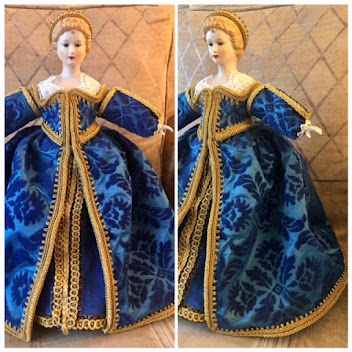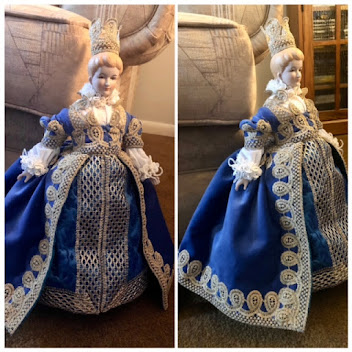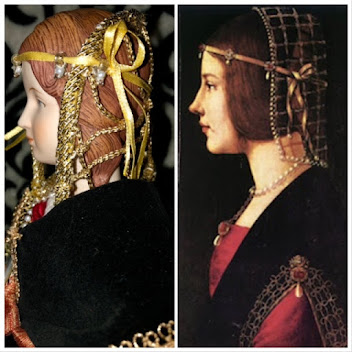Fashion Dolls especially those in the 16th century are an item of privilege. They were an accessory for noble girls around the age of 5. Made out of precious fabric like silk, metallic trims and featured human hair wigs on either wire, clay, or wood body. These Fashion dolls typically were highly decorated items that would have taken hours or days to create each part to exact detail. The nobility of Europe being the top of the social hierarchy, fashion dolls would not be a cheap commodity.
There would be several guild artisans to make just one doll dressed from the skin out. Woodcarvers, jewelers, clay sculptors, figure painters, possibly a miniaturist, glass-maker for beads, and a seamstress or tailor to assemble the entire creation and create the clothing. It could be argued an expensively made fashion doll could be the cost of doing business with noble clientele. Not all tailors could afford to use scraps in a sales-forward manor to drum up business. The marketing ability to sell one's work, as well as make orders all day for clients was a challenge for any business owner. Fashion Dolls were a known export to the new world to communicate fashions of the time, and France was a chief exporter of these goods. Still not cheap to purchase, many rented for a time from the owner to be taken to a tailor or dressmaker to have clothing made up in the latest fashion.
As an offshoot of the doll or puppet that occurred much earlier in Europe before the discovery of the New World, the Roman Catholic Church understood the symbolism and influence of the saints. They promoted morality plays in the inner sanctums of larger churches, Basilicas, and Cathedrals on feasts and festivals on the liturgical calendar. Santos Dolls were designed with a religious nature in mind, more as a dressable statue. These dolls could be decorated with rich fabrics, trims, and opulent ornamentation. Meant to grace private chapels and churches these dolls were typically larger in nature to fill a space, so dolls could be 12"- 24" tall or more. Another made-to-order type of item, they could be customized to the wishes of the client. Many of these dolls were made from wood and were painted with a lighter skin tone. There were Santos Dolls made in some darker-skinned toned saints, but most tend to look Caucasian in coloring.
These dolls made their way to the new world with the Spanish colonization of Latin America. Santos Dolls can still be seen in Roman Catholic churches in Latin America in modern times. On feast days they will even be carried on a litter around in a procession. These as symbols would have been a tool to convert the Native population to the Catholic faith. Conversion is not a gentle choice in the age of discovery, typically it was a convert or die choice. Persuasion methods were used by monks and priests to force conversions to their faith. The Latin-American community still has influences of colonialism in their culture to this day, beauty standards still lean towards a pale complexion as a mark of beauty and wealth; among many other influences from the past and present.
With the inquisition still in full force in Spain is emboldened by the blessing of the Roman Catholic Church forces, many thousands faced the judgment of tribunals. Using torture as a means to drive confessions to seek out those who were considered undesirable. Which meant during this time anyone that would be LGBTQ+, racially or religiously different. Charges ranged from various sorts of acts; bigamy, unnatural marriage, bestiality, pedophilia, incest, sodomy, and witchcraft. There were various non-religious crimes; human trafficking, smuggling, forgery, tax fraud, conspiracy, treason, procurement\prostitution. Inquisitors prosecuted both types of crimes as there was not a separate court for the state at the time.
In conclusion, the past does have an effect on the present if we don't accept what was wrong and work to correct those wrongs. Change is possible but hard to unlearn from centuries of systemic racism, elitism, and colonialism. Actively working towards equity, through social change driving political change, can we become a better society that we state in this country's ideals.
Working Towards a More Perfect Union,
Marrin
Further Reading:






No comments:
Post a Comment